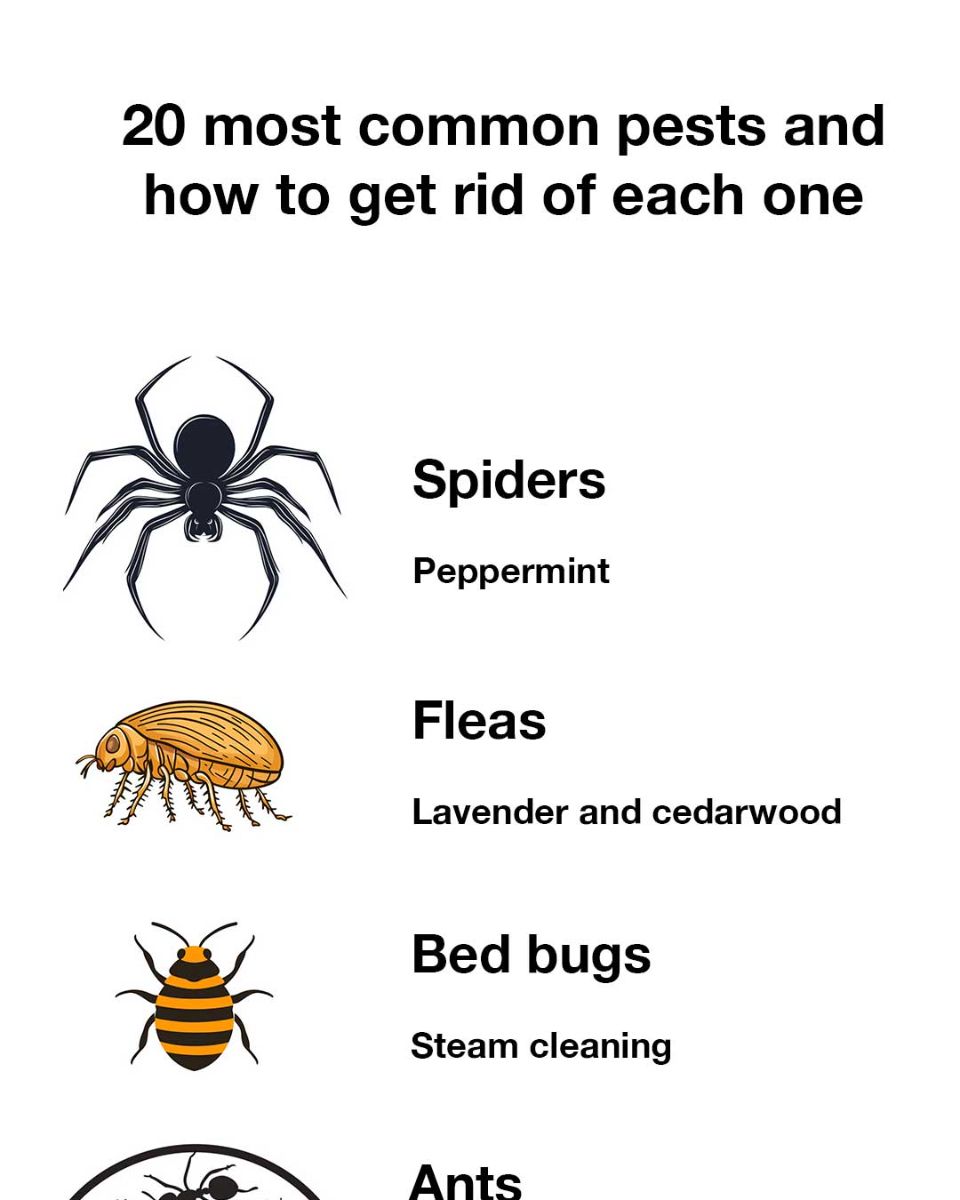20 most common pests and how to get rid of each one
Morgan Reed
Contributing Writer
Print this recipe
Household pests are an unwelcome reality for many homeowners, causing damage to property and posing health risks. These pests range from insects like ants and cockroaches to larger animals like rodents. Understanding the types of pests that commonly invade homes is the first step in effectively managing and eliminating them. This article explores the most common household pests and provides natural solutions for dealing with them.
Understanding the Impact of Pests on Homes and Health
Pests can have a significant impact on both the structural integrity of homes and the health of their inhabitants. Termites, for example, can cause extensive damage to wooden structures, while rodents can chew through electrical wiring, creating fire hazards. Health-wise, pests like mosquitoes and ticks are known vectors for diseases such as West Nile virus and Lyme disease. Cockroaches and rodents can also trigger allergies and asthma in sensitive individuals. Therefore, effective pest management is crucial for maintaining a safe and healthy living environment.
1. Natural Remedies for Fleas and Why They Work
Fleas are parasitic insects that reproduce quickly, making them difficult to eliminate. The following natural remedies are effective:
Diatomaceous Earth (DE): A fine powder that dehydrates fleas by absorbing the oils from their exoskeletons, ultimately killing them. Lightly sprinkle food-grade diatomaceous earth on carpets, pet bedding, and floors. Let it sit for 12-48 hours before vacuuming to dehydrate and kill fleas. For pets, apply a small amount to their fur, avoiding the face, and brush out after a few hours. Repeat weekly for best results.
Essential Oils (Lavender & Cedarwood): Lavender disrupts flea egg-laying behavior, while cedarwood oil acts as a potent natural flea repellent. Mix 2 cups distilled water, 1 tbsp witch hazel, 10 drops lavender oil, and 10 drops cedarwood oil in a spray bottle. Shake well and spray on pet bedding, carpets, and lightly on pets (avoiding eyes and mouth) to repel fleas. Reapply as needed.
Hot Water Washes: Washing pet bedding and household fabrics in hot water (at least 130°F) kills fleas, eggs, and larvae.
Regular Vacuuming: Eliminates flea eggs and larvae from carpets and upholstery, preventing reinfestation.
2. Effective Strategies to Eliminate Bed Bugs
Bed bugs are highly resilient and excellent at hiding. Natural control strategies include:
Heat Treatments (Steam Cleaning): Bed bugs die at temperatures above 120°F, making steam an effective way to kill them in mattresses, upholstery, and carpets.
Mattress & Pillow Encasements: These prevent bed bugs from hiding and laying eggs, cutting off their life cycle.
Frequent Cleaning & Decluttering: Reducing hiding spots makes it harder for bed bugs to thrive.
3. Natural Solutions for Beetle Infestations
Beetles can damage food, clothing, and plants. These remedies help prevent and eliminate them:
Neem Oil: Contains azadirachtin, which disrupts beetle growth and reproduction.
Diatomaceous Earth (DE): Causes dehydration, killing adult beetles and larvae.
Airtight Storage: Keeping grains and dry food in sealed containers prevents beetle infestations.
4. How to Safely Remove Spiders from Your Home
Spiders can be beneficial but often unwelcome indoors. Natural methods to deter them include:
Peppermint Essential Oil: Spiders dislike its strong scent; spraying diluted oil around entry points keeps them away. Mix 2 cups of water, 1 tablespoon of dish soap, and 10-15 drops of peppermint essential oil in a spray bottle. Shake well and spray around windows, doors, baseboards, and other entry points to repel spiders. Reapply every few days or as needed.
Decluttering & Regular Cleaning: Removing webs and sealing cracks eliminates hiding places.
Sealing Entry Points: Blocking small gaps in windows and doors prevents spiders from entering.
5. Moth Control: Natural Recipes and Prevention Tips
Moths destroy fabrics and pantry items. The best natural solutions include:
Cedarwood: Contains natural oils that repel moths; use cedar blocks or shavings in closets.
Lavender Sachets: Dried lavender naturally repels moths while adding a pleasant scent.
Frequent Closet Cleaning: Regularly vacuuming and rotating stored clothing disrupts moth breeding cycles.
6. Ants: Natural Deterrents and Long-Term Solutions
Ant infestations occur due to food and moisture availability. Natural solutions include:
Vinegar & Lemon Juice: Disrupts the pheromone trails ants use to navigate.
Diatomaceous Earth (DE): Cuts through the exoskeleton of ants, killing them on contact.
Sealing Entry Points: Prevents ants from accessing food sources inside the home.
7. Wasps: Safe Removal Techniques and Natural Repellents
Wasps can be aggressive, making natural deterrents crucial:
Peppermint Oil Spray: Repels wasps from common nesting areas.
Eucalyptus Plants: Naturally deters wasps when planted near patios and doorways.
Garbage & Food Management: Removing food sources, such as sugary drinks and exposed trash, prevents wasps from lingering.
8. Fruit Flies: Homemade Traps and Prevention Methods
Fruit flies reproduce quickly, so early intervention is key:
Apple Cider Vinegar & Dish Soap Trap: The vinegar attracts flies, and the soap prevents them from escaping.
Refrigeration of Produce: Keeps fruit out of reach, limiting fruit fly breeding opportunities.
Regular Trash Disposal: Prevents fruit fly eggs from hatching inside compost or trash bins.
9. Cockroaches: Natural Methods to Keep Them at Bay

